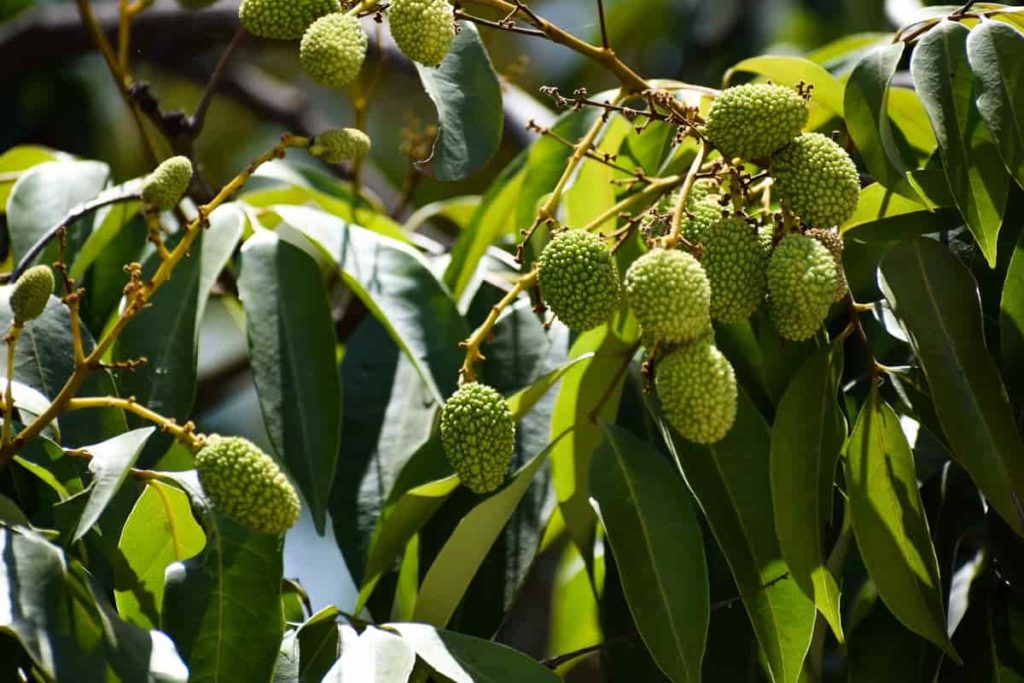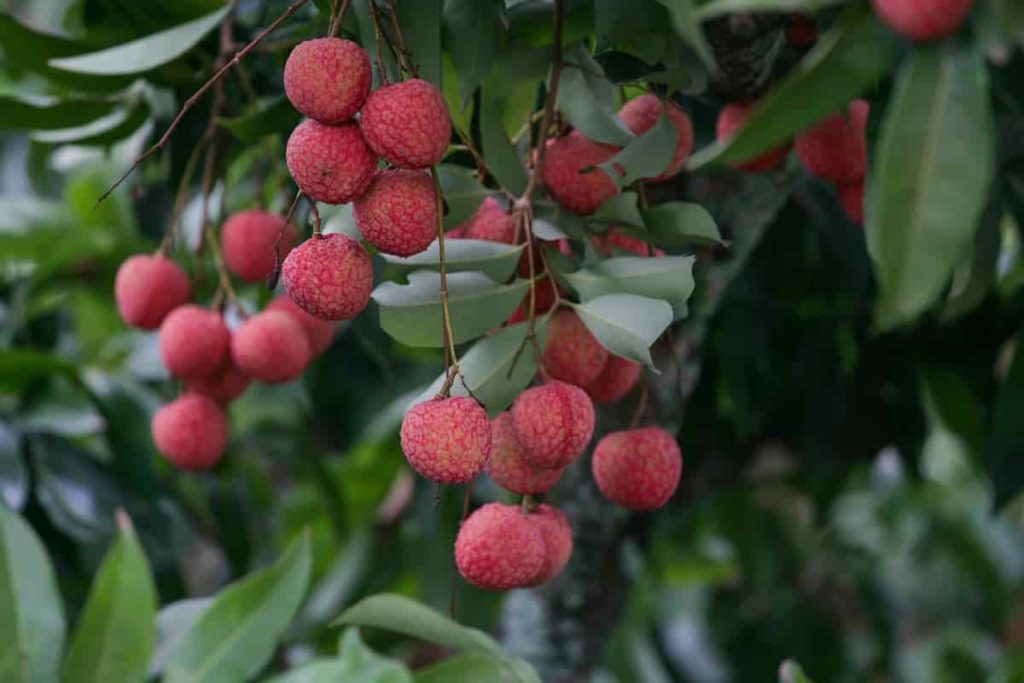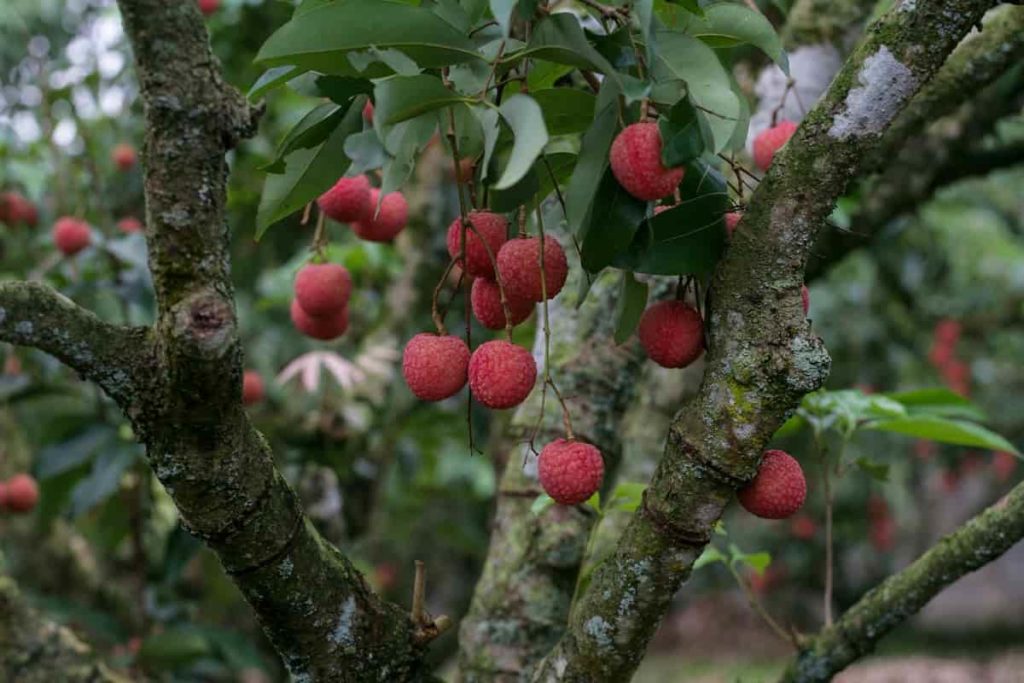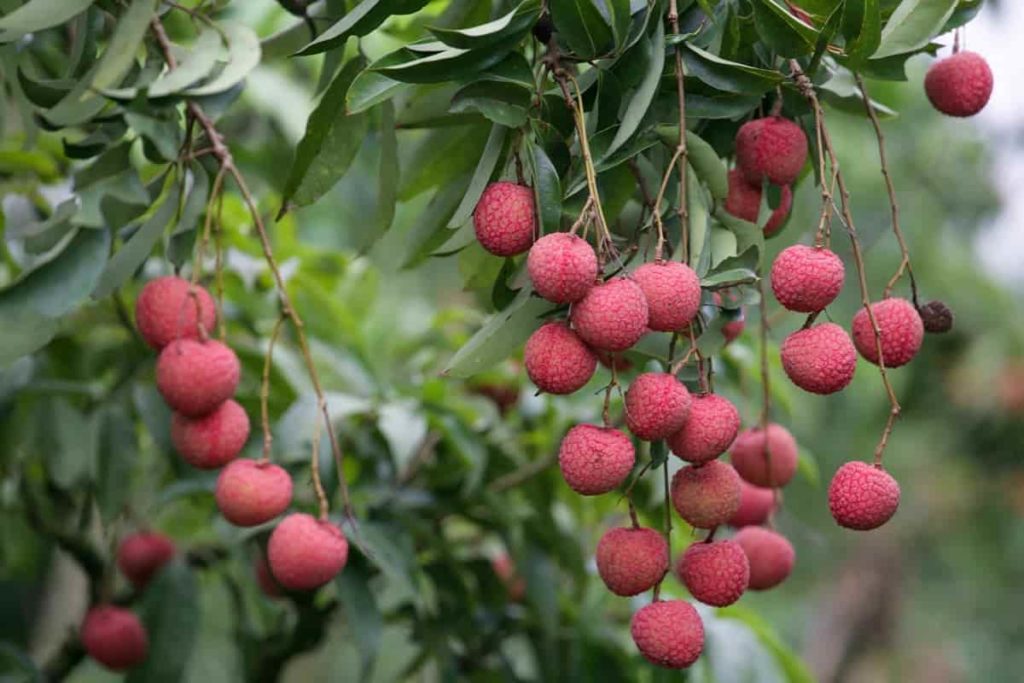The Lychee plant needs nutrients to grow satisfactorily and give fruit. It did take a long time for the trees to respond to the application of fertilizer. It would be best if you met the nutritional needs of plants through the supply of adequate nutrients from organic manures and fertilizers, which results in the best yields. Nitrogen is an essential nutrient affecting the Lychee plant’s growth and productivity. Let’s check out the best fertilizer for Lychee tree.

Like other plants, nitrogen plays a critical role in the developing vegetation in the Lychee gardens and has a clear impact on the trees. Low amounts of phosphorus are rare where mixed fertilizers are regularly applied. It is because phosphorus is not easily leached from the topsoil. Once the soil phosphorus concentration is high, it lasts for many years. Potassium is an essential nutrient for the fruit’s size, weight, and quality.
The production and transportation of plant sugar require potassium which increases the weight of fruits. New growth depends more on the reserves in the tree than on the fertilizer sown on the soil recently. When the concentration of a nutrient reaches an unusually low or high level in the Lychee plant, unusual symptoms appear in the leaves.
Best fertilizer for Lychee tree
Homemade fertilizers for Lychee
- Wood ash – You can place wood ash around the Lychee tree. Wood ash is an excellent addition to fruit trees due to its properties. Wood ash contains potassium, and it is a significant nutrient of plants associated with flowers and fruits.
- Neem cake – The use of neem cake and manure increase’s the quality and production of Lychee fruits.
Compost manure for Lychee
- Manure – If you are using cow manure, spread two or three shovels around the base of the Lychee tree. It will slowly increase the fertility of the soil.
- Compost – When plating, mix compost in the topsoil and fill 2 to 3 inches under the hole with soil.
In case you missed it: How To Start Lychee Garden – Planting FAQs

Natural fertilizers for Lychee
Organic mulch, derived from yard waste and a chipped material, helps promote a uniformly healthy microclimate on top of the roots. As a result, it reduces the stressful cycle of wetting and drying the root system. These conditions also create a healthy environment for soil construction, such as bacteria and fungi.
Most Lychees are propagated as air-layers and thus develop a shallow root system that spreads to the surface without a deep taproot. The decaying organic matter in mulch helps acidify the soil, which is particularly important in the limestone soil of the tropics. The Lychee trees produce a hemispherical shape that naturally forms a canopy to shadow the root system.
Organic and liquid fertilizers for Lychee
- Bone meal – Bone meal provides phosphorus to fruit trees. Phosphorus promotes early growth, root formation, and fruit growth.
- Seaweed and kelp – If using seaweed or kelp liquid fertilizer, mix 60 milliliters of liquid in a gallon of the water jug and sprinkle the mixture around the base of the Lychee tree.
- Fish emulsion – During warm months, balanced applications of fish emulsion regularly (every two weeks in hot weather) will boost steady growth.
In case you missed it: Lychee Growing Tips, Techniques, Ideas, and Secrets

Commercial fertilizers for Lychee
Find a fertilizer with high potassium and low nitrogen levels for fruity and flowering plants. It will encourage fruits and flowers without promoting the growth of too many leaves. After harvesting the first fruit, fertilize with half the power of 10-5-20 fertilizer applied. Do not re-fertilize until the fruit is fixed for another fruit crop. Fertilize during the second fruit with half the strength of 10-5-20 fertilizer when the fruits are the size of peas.
Micronutrients are usually applied through the foliar spray at the time of their deficiency. The frequency and time of spray depending on the severity of the deficiency. Boron and zinc sprays are usually applied annually. Every 2 to 3 years, using a single soil application during summer can also overcome the deficiencies of zinc, boron, and copper.
Lychee fertilizer schedule
The fertilizer application schedule for the young Lychee plant starts with organic manure, including the cake. You need not feed newly planted plants in the first year. It is generally not advisable to apply any fertilizer at the planting time; however, you should use manure and cake well before the pit filling. Almost all soils suitable for planting the Lychee contain enough available nutrients to help the plant grow for at least a year.
In case you missed it: Gardening In Florida – Frequently Asked Questions

If the soil is too poor to sustain the plant even for a year, you should replace the entire pit soil and arrange good soil with nutrients. 25 kg of farmyard manure, 0.75 kg of bone meal, and 2 kg of neem cake can be applied during the filling of the pit. Once the plant is established, it requires an overdose of calcium, nitrogen, and phosphorus for early growth. Potassium is also necessary for adequate quantity.
Calcium levels are not essential to apply in soils with high calcium content, but in soils where pH ranges between 5.5 and 6.5, calcium may be required to be added in the form of dolomite lime. Nitrogen is essential during non-bearing periods to encourage vigorous growth in sufficient quantities. Therefore, it would be better to obtain some part of the nitrogen from organic matter to improve soil structure, moisture-keeping capacity, and eventually root growth and development.
Phosphorus is required to deal with high rates of respiration and transfer carbohydrates during the intolerant phase. Potassium is necessary to meet the need for photosynthesis. Still, during a non-bearing period, it is relatively less needed than in the bearing period when it is required to synthesize high amounts of sugar and starch. The fertilization program for the initial bearing stage can start from the third year and continues until they are entirely on stage.
In the fourth year of planting, if trees are grown well in spring and flushed vigorously, nitrogen fertilization is stopped until the leaf color falls or the fruit starts. In the form of fully developed bearing trees, nutrition management is first instructed to achieve maximum vegetative growth immediately after harvesting fruits in summer. The second requirement is to keep the inactive tree condition for 3 to 4 months before flowering. The third requirement is to maintain nutrition at a higher rate after the fruits are set to prevent stress.
Nutrients are applied twice a year. The first request has been made four weeks after the fruit set and two weeks after harvesting to encourage fruit growth. In the following years, once harvested and once the fruits are the size of peas, continue to fertilize. Apply 453 grams of fertilizer for every inch of trunk diameter each year, measured at 4 feet above the ground. The application of nitrogen during autumn and winter can encourage excessive flushing before the expected period of flower initiation, so you should not apply it.
In case you missed it: Growing Raspberries Indoors in Pots (Containers)

The application of nitrogen in early spring can boost growth flushing that can withstand flowers and reduce the shedding. However, since the main objective of any fertilizer program is to achieve maximum production, you should direct the fertilizer management towards maintaining the tree in inactive condition for 3 to 4 months before flowering. After that, it is necessary to stop the fertilizers for a year, to get too many flowers and a good yield. However, you should take a lot of caution because the drastic reduction in N, P, and K prevents development and hinders development and flowering.
Therefore, it is not surprising that the increase in the application rate of these nutrients at the right time has a favorable effect on the final size and weight of the flower, fruit set, and fruit. Maintaining high growth rates immediately after harvesting is also essential to get an excellent vegetative flush in the summer. Fertilizers should not be stopped during flowering to harvesting to ensure good production.
How to fertilize Lychee in pots
Growing Lychee in containers is not easy; it needs special care, warmth, and sunlight. Every two weeks in spring and summer, the Lychee trees are fed by the water-soluble fertilizer formulated for acid-loving plants. When the trees are young, use the fertilizer at one-half the strength, about 1/2 teaspoon crystals per 1 gallon of water. When the trees reach the age of fruiting, increase this amount to 1 teaspoon per 1 gallon of water, but avoid fertilizing them during fall and winter.
In case you missed it: Growing Rambutan Tree Indoors from Seed – A Full Guide

It is better to use organic fertilizers like kelp and fish emulsion. When you fertilize, make sure you spray minor elements on the leaves, transplant your Lychee tree into a new container, and spray liquid phosphorus fertilizer on leaves to promote the flowers and fruits annually.
Frequently asked questions about fertilizers for Lychee (FAQ)
Why is my Lychee not producing fruit?
Lychee trees do not start producing fruit from planting for three to five years when grown from cuttings or grafting. Seed-grown trees can take 10 to 15 years to bear fruit. So, a lack of fruit can only mean that the tree is too small.
How to encourage my Lychee to bloom?
The Lychees have a reputation as drought tolerant, but you need to irrigate newly planted Lychee trees regularly during the first few seasons. However, irrigation can reduce flowers after the trees mature. Stop watering trees during fall and winter until they open. It usually produces more flowers.
Why do the Lychee leaves turn brown?
Leaves that only turn brown on their tips can indicate the water problem, either too much water or too little. Tip burn can also be a symptom of fertilizing or nutrient deficiency.
- Flower Garden Designs and Layouts for Beginners
- Planting and Spacing Techniques in Papaya: A Beginner’s Guide
- Growing Gold: Essential Techniques for Planting Pineapples
- How to Make Kalanchoe Plant Bushy: Home Remedies and Solutions
- 11 Reasons Why Your Gardenia is Not Blooming: Home Remedies and Solutions
- Eco Elegance: The Guide to Designing a Drought-Tolerant Landscape
- Gardening on a Slope: Strategies for Hillside Landscaping
- Nourish and Flourish: Top Organic Mulches for Thriving House Plants
- Everything You Want to Know about Indian Mogra Flower: Discover Uses and Growing
- Green Thumb Success: Expert Tips for Cultivating Greenhouse Pumpkins All Year Round
- Maximize Growth & Flavor: The Ultimate Guide to Companion Planting in Herb Gardens
- How to Control Rhododendron Problems Naturally: Home Remedies and Organic Ways to Fix Them
- Natural Magic: The Remarkable Benefits of Cinnamon for Plants
- Best Steps to Revive Dying Tulip with Natural and Organic Treatment
- 10 Reasons Why Your Angel Trumpet is Not Blooming: Remedies and Treatment
- How to Fix Periwinkle Leaf and Flower-Related Problems: Natural Remedies and Solutions
- How to Fix Zinnias Leaf and Flower Problems: Discover Natural and Home Remedies
- Organic Steps to Induce Lemon Tree Flowers: A Comprehensive Guide
- Bloom Booster: Crafting the Perfect Homemade Bougainvillea Fertilizer
- Optimizing Growth: A Guide to Applying NPK Fertilizer for Potted Plants
- 10 Best Homemade Fertilizers for Rubber Plant: DIY Recipes and Application Method
- How to Boost Female Pumpkin Flowers: Effective Steps for More Flowers and High Yields
- Transform Your Indoor Garden: Top Benefits of Pink Salt for Houseplants
- 10 Best Homemade Fertilizers for Peacock Plants (Calathea): Easy DIY Guide
- Unlock Blooms: 9 Reasons Why Your Potted Chrysanthemum is Not Blooming
- 8 Reasons Why Your Potted Hibiscus is Not Blooming: Fix it with Simple Solutions
- Unlock Blooms: 9 Key Reasons Your Potted Frangipani Won’t Flower
- 10 Reasons Why Is My Ice Plant Not Blooming: Remedies and Treatment
- 10 Reasons Why My Potted Hydrangea Not Blooming: Treatment and Remedies
- 10 Reasons Why is My Wisteria Not Blooming: Remedies and Treatment
- 10 Reasons Why is My Goldfish Plant Not Blooming: Remedies and Treatment
- Maximize Your Space: Ultimate Guide to Balcony Gardening with Grow Bags
- 10 Reasons Why Your Iris is Not Blooming: Remedies and Treatment
- 10 Reasons Why Your Anthurium Plant is Not Blooming: Treatment and Remedies
- 10 Reasons Why Your Aquaponic Plants Are Not Flowering: Remedies and Treatment
- 10 Reasons Why Your Agapanthus is Not Flowering: Remedies and Treatment